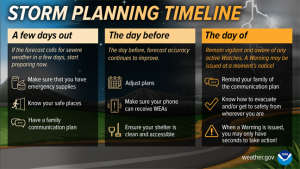The week of March 3-9 has been designated as Severe Weather and Flood Preparedness Week South Carolina.
The Statewide Tornado Drill is scheduled for Wednesday, March 6th at 9:00 a.m.
During South Carolina’s annual Severe Weather and Flood Preparedness Week, the South Carolina Emergency Management Division (SCEMD) and the National Weather Service jointly work to remind people that severe storms, tornadoes and flash floods are significant hazards in South Carolina and people need to take proper safety precautions.
With warmer weather quickly approaching, now is the time to prepare for the severe weather season.

Types of Severe Weather
Severe Thunderstorms
A thunderstorm is a local storm that produces lightning and thunder. Severe thunderstorms are officially defined as storms that are capable of producing hail that is an inch or larger or wind gusts over 58 mph. Hail this size can damage property such as plants, roofs, and vehicles. Wind this strong is able to break off large branches, knock over trees or cause structural damage.
Tornadoes
A tornado is a violently rotating column of air extending from the base of a thunderstorm down to the ground. Tornadoes are capable of completely destroying well-made structures, uprooting trees, and hurling objects through the air like deadly missiles. Tornadoes can occur at any time of day or night and at any time of the year. South Carolina averages 20-25 tornadoes a year statewide.
Lightning
Lightning strikes the United States about 25 million times a year. Although most lightning occurs in the summer, people can be struck at any time of year. Lightning kills 20 or more people in the U.S. each year, and hundreds more are severely injured. Most of these tragedies can be prevented. When thunderstorms threaten, get inside a building with plumbing and electricity, or a hard-topped metal vehicle!
Flooding
Flooding is the number one storm-related killer in the United States (and second weather-related killer behind heat). Why? Most people fail to realize the power of water. More than 50 percent of flood-related deaths are due to someone driving or walking into floodwaters.
Watches
and Warnings
Do you know the difference between a National Weather Service Watches and Warnings for severe weather? These include Severe Thunderstorm, Tornado, and Flash Flood Watches and Warnings. A Watch means Be Prepared, as severe weather is possible in or near the watch area. A Warning means Take Action, as severe weather is expected imminently. Read more below about the various severe weather watches and warnings issued by the NWS.
Severe Thunderstorm Watch: Be Prepared! Severe thunderstorms are possible in and near the watch area. Stay informed and be ready to act if a severe thunderstorm warning is issued. Have multiple ways to receive warnings. The watch area is typically large, covering numerous counties or even states.
Severe Thunderstorm Warning: Take Action! Severe weather has been reported by spotters or indicated by radar. Warnings indicate imminent danger to life and property. Take shelter in a substantial building. Get out of mobile homes that can blow over in high winds.
Tornado Watch: Be Prepared! Tornadoes are possible in and near the watch area. Review and discuss your emergency plans and check supplies and your safe room. Be ready to act quickly if a warning is issued or you suspect a tornado is approaching. Acting early helps to save lives! Have multiple ways to receive warnings. Watches are issued by the Storm Prediction Center for counties where tornadoes may occur, and typically covers a large area.
Tornado Warning: Take Action! A tornado has been sighted or indicated by weather radar. There is imminent danger to life and property. Move to an interior room on the lowest floor of a sturdy building. Avoid windows. If in a mobile home, a vehicle, or outdoors, move to the closest substantial shelter and protect yourself from flying debris.
Flash Flood Watch: Be Prepared! Flash flooding or flooding is possible within the watch area.
Remain weather aware and be prepared to take action if a flash flood warning is issued for your area.
zHave multiple ways to receive warnings. Flood watches are issued by local NWS offices and typically encompass large areas.
Flash Flood Warning: Take Action! A flash flood is imminent or occurring.
If you are in a flood prone area, move immediately to high ground. Never drive or walk through floodwaters.
A flash flood is a sudden violent flood that can take from minutes to hours to develop. It is even possible to experience flash flood in areas not immediately receiving rain.
If each South Carolina resident would take a few moments this week to learn about severe weather and flood safety and implement a safety plan, then we would all be better off when severe thunderstorms, tornadoes, and flooding inevitably strike our state and the likelihood of injury and fatalities caused by severe weather and flooding could be minimized.


